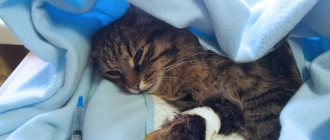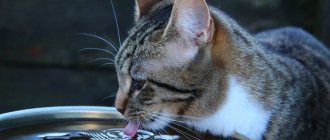5398Pavel
“Nepnritis” translated from Greek, nephritis is a severe, infectious-allergic disease that directly affects the kidneys. It can occur acutely, subacutely and chronically, and the area of localization is diffuse and focal. Depending on the stage of the disease, the symptoms and treatment of nephritis in cats vary. The kidneys act as a kind of filter, taking on all the negative consequences of infectious diseases, inflammatory processes and allergic reactions. It is important to understand that this is a dangerous disease that requires the intervention of a qualified specialist.
What is nephritis in cats
Nephritis is an inflammatory disease of the kidneys, the causes of which can be a number of factors with a possible recurrent course and the development of complications. The mechanism of disease development, depending on the type and stage of the disease, has its own clinical picture and pathomorphological specificity. Nephritis includes acute and chronic inflammatory processes of the renal glomeruli (glomerulonephritis), renal tissues and tubules (interstitial nephritis), causing proliferative or destructive processes in the kidneys.
The acute form of the disease occurs mainly after a bacterial or viral infection, less often it manifests itself as a result of poisoning, skin burns, dermatitis, including infectious and allergic etiology. Hypothermia of the animal, injury and other causes contribute to the appearance of illness.
Prevention
It is easier to prevent a disease than to eliminate its consequences. We suggest you familiarize yourself with the basic preventive measures that will help keep your pet healthy.
- Proper nutrition. It is necessary to provide cats and kittens only with high-quality food, preferably home-cooked. If you can’t cook yourself, you can feed him dry food of at least premium class. It should also be excluded from the diet; salted, smoked, fatty, fried.
- Physical exercise. A sedentary lifestyle in cats leads to the formation of excess fat cells and metabolic disorders. This can cause kidney disease, including nephritis. Therefore, the pet must be provided with a sufficient amount of physical activity. For example, playing with a ball or using special game “fishing rods”.
- Avoid hypothermia. To prevent kidney disease, you need to keep your cat warm and avoid drafts.
- Weight control. If your pet is overweight, then it is necessary to use a health-improving diet.
- Taking vitamins. Premium and superpremium cat food contains a sufficient amount of vitamin complexes and no additional vitamin intake is required. If the diet consists only of natural products, without the use of dry food, then it is necessary to add vitamins to the food.
- Drinking water. For proper kidney function, it is necessary to provide the animal with constant access to clean, drinking water. Cleanliness of the cat's litter box. It must be regularly treated with special disinfectants.
We suggest you read: Male turtle dove behavior
The prognosis for the acute course of the disease is in most cases unfavorable. Therefore, the sooner a cat gets to the doctor, the greater the chance of a quick cure for nephritis without complications. If, when symptoms are detected, it is not possible to hospitalize the animal yourself, keep the pet warm and limit access to food until the doctor arrives.
>Chronic nephritis in a cat treatment
Symptoms of nephritis in cats
The initial symptoms of the disease in an animal are:
- lethargy;
- chills, increased body temperature;
- deterioration or lack of appetite;
- thirst;
- significant increase in blood pressure;
- swelling of the eyelids;
- frequent urination (pollakiuria), while the amount of urine produced decreases;
- presence of blood in the urine (hematuria) and pus;
- unpleasant smell of urine.
Also, one of the characteristic symptoms of the disease in the acute form is pain that occurs upon palpation in the kidney area, which manifests itself as anxiety in animals.
Low back pain may result in a stiff gait and a hunched position.
Causes
The disease can be caused by bacteria, usually Staphylococcus, E.coli, Proteus. Microbes infect the kidney tissue, spreading from the bladder, urethra, or from the ureter if poorly treated. Sometimes the pathology is provoked by autoimmune disorders, when the body's defense cells mistakenly attack the kidney tissue.
There are provoking factors that contribute to the development of nephritis:
- the presence of infection in the genitourinary system;
- constant hypothermia;
- long-term chronic disease in a cat;
- sedentary lifestyle;
- poor nutrition and vitamin deficiencies.
Diagnosis of nephritis in cats
However, the above symptoms are not enough to make a correct diagnosis, since most of them may indicate the presence of other diseases of the animal’s genitourinary system.
In this regard, it is very important to conduct timely laboratory tests when diagnosing the disease. Urinalysis is aimed at isolating infectious microorganisms - the causative agents of the disease and determining their quantity during bacteriuria for the presence of blood, epithelial cells, protein, a significant amount of which appears at the onset of the disease (subsequently its content decreases), determining the density and pH of the urine reaction (usually , it is sour). Conducting such laboratory tests gives a complete picture of kidney function.
Within 2-3 weeks, depending on the cause of the disease and the condition of the body, if the first symptoms are ignored or as a result of unqualified treatment, the acute form may become chronic.
Unlike the acute form, chronic nephritis is manifested by frequent urination with a large volume of urine excreted (polyuria). In this regard, the animal’s thirst increases. There is pallor of the mucous membranes with a gray tint, severe swelling on the abdomen, eyelids, paws, and perineum. Anemia develops, vomiting, gastrointestinal disorders appear and, as a result, an unpleasant odor from the mouth. The kidneys are dense, however, they are little painful. Body temperature does not exceed normal.
The veterinarian's office will perform a complete blood count, including a blood chemistry profile, a complete blood count, and a urinalysis. The results of a complete blood count are usually insignificant. In severe cases, a biochemical profile may reveal abnormally low levels of the protein albumin in the blood (hypoalbuminemia) and high levels of cholesterol in the blood (hypercholesterolemia). The presence of blood proteins and other proteins in the blood can help your veterinarian make an initial diagnosis. In cats with kidney failure, urinalysis will reveal corresponding changes in the urine.
Creatinine is a waste product normally excreted by the kidneys, and its presence in urine is measured as a diagnostic indicator of kidney function. A more accurate test calculates the urine to creatinine ratio to give your veterinarian an idea of the extent of kidney damage. The degree of protein loss in urine roughly correlates with the severity of kidney disease. Thus, measuring the protein to creatinine ratio also helps in assessing response to treatment and disease progression or regression.
Quite often, nephritis is diagnosed late, only when signs of renal failure have already begun to appear.
Signs of chronic glomerulonephritis and methods of combating it
Have you been trying to cure your KIDNEYS for many years?
Head of the Institute of Nephrology: “You will be amazed at how easy it is to heal your kidneys just by taking it every day...
Chronic glomerulonephritis is an immunoinflammatory chronic kidney disease that initially affects the renal glomeruli and tubules, subsequently spreading to other kidney tissues. Slowly progressing, damaged kidney tissue is replaced by connective tissue, sclerosis occurs, leading to chronic renal failure.
Kidneys are paired organs that perform the function of urine formation through chemical self-regulation of the body, thereby removing foreign compounds and toxic substances from the body. They take part in carbohydrate and protein metabolism and in the formation of a number of biologically active substances.
The main load during blood filtration falls on the renal glomeruli with tubules and Bowman's capsule (nephrons). At the time of birth, nephrons have already formed, but continue to mature for about 10 years. Since new glomeruli are no longer formed after birth, their loss leads to kidney failure.
Upon completion of filtration, urine is excreted through the renal tubule into the renal pelvis, from where it drains into the bladder.
First of all, with glomerulonephritis, changes occur in the nephrons:
- Due to inflammation, microthrombi form in the glomeruli, which close the space in the vessels. Blood stops flowing into the nephrons. The entire procedure of blood filtration and the formation of primary urine in the affected glomerulus is disrupted.
- Since blood does not flow into the affected vessels, voids form in them, which are replaced by connective tissue. Nephron function declines.
- The more nephrons are involved in the process, the less blood is filtered by the kidneys, and kidney failure appears.
- Kidney failure leads to the accumulation of harmful substances in the body, and beneficial substances do not have time to return to the blood.
Stages
Chronic glomerulonephritis undergoes several stages:
- Compensation stage. This is an early stage in the development of the disease. At this stage, the kidneys are functioning without visible disturbances. There is a moderate increase in blood pressure and slight swelling. A slight increase in protein in the urine, a change in its density, the presence of modified red blood cells. The concentration of urine decreases.
- Stage of decompensation. At this stage, kidney function is impaired and renal failure occurs. Blood pressure numbers are high, the body is poisoned with nitrogenous compounds, and daily urine output increases. The level of protein in the urine increases, the presence of casts and red blood cells increases, and the density of urine decreases.
- Uremia. The most difficult stage. The kidneys cannot maintain the correct composition of the blood. Intoxication with residual nitrogen, creatinine, and urea appears.
Chronic glomerulonephritis can be infectious-immune and non-infectious-immune.
Types of glomerulonephritis:
- Latent glomerulonephritis. The most common type, it accounts for 45% of the total number of patients. Symptoms are mild. Slight increase in blood pressure, mild swelling. The disease can be identified by the results of a laboratory test: protein, red blood cells and white blood cells are increased in the urine. Lasts a long time, up to several decades. Systematic outpatient monitoring of the patient is required. Working capacity is not impaired.
- Hematuric glomerulonephritis is rare, accounting for about 5% of all cases of chronic glomerulonephritis. There is an increased content of altered red blood cells in the urine, which is why the urine is red or pink. Anemia is sometimes observed. Renal failure occurs infrequently, and the course of the disease is favorable.
- Nephrotic glomerulonephritis. It affects 25% of the total number of cases of glomerulonephritis. With this type, the pressure is increased, there is severe swelling, and little urine is produced per day. There is protein in the urine, the density of the urine is increased. In a biochemical blood test, cholesterol is increased and total protein is decreased. This type of glomerulonephritis progresses moderately, but rapid progression is also possible. Kidney failure develops.
- Mixed form of the disease. Occurs in 7% of cases. Repeats the symptoms of hypertensive and nephrotic types. It is characterized by a persistently progressive course and the formation of chronic renal failure.
Any form of the disease has two phases:
- Compensated. The kidneys are working normally.
- Decompensated. The kidneys work with impairment of their functions, chronic or renal failure progresses.
The result of chronic glomerulonephritis is the formation of chronic renal failure. The very first symptom is a decrease in the relative density of urine (isosthenuria) and an increase in the amount of urine excreted per day (polyuria). Diuresis increases at night (nocturia). Signs of uremia appear. The body is poisoned with nitrogenous substances and uremia develops.
Tubulointerstitial nephritis is a disease that is known to a small number of people. According to medical statistics, this disease in most cases affects individuals over 60-65 years of age. Only in 2% of cases is it found in the younger population.
Basic concept
Tubulointerstitial nephritis is a nonspecific disease that affects the liver. A rapidly occurring inflammatory process negatively affects the hepatic soft tissues and its canal passages. If treatment is not started in a timely manner, atrophy is possible. The etiology of this disease varies.
We suggest you read: Trained cats at home
In cats and dogs, symptoms of the disease appear in advanced cases, when 70% of the functional elements of the kidney have already died.
The first symptom is frequent urination. This symptom is not always paid attention to, considering that it is natural, but it is a very formidable symptom, since there is no secondary absorption of water from the kidneys into the bloodstream. To compensate for the loss of fluid in the body, animals begin to drink more.
Signs of uremia: apathy, depression, refusal to eat, exhaustion, dry hair, brownish coating on the surface of the tongue, the presence of ulcers on the tongue and gums, ammonia-like odor from the mouth when breathing. Vomiting, diarrhea and gastrointestinal bleeding appear. Anemia develops. As a result, the animal falls into a coma. In case of development of nerve-paralytic phenomena, the prognosis is 99% unfavorable.
Thus, only timely treatment can save an animal’s life even if the kidney tissue is severely damaged, but treatment must be systematic and supportive. As soon as you stop providing maintenance therapy, the symptoms of the disease will reappear.
Treatment of chronic renal failure should be aimed at improving urination and detoxification. The drug “PHYTOELITA Healthy Kidneys” is absolutely indispensable. The mechanism of action of the drug is determined by the phytotherapeutic activity of biologically active substances from extracts, decoctions and infusions of medicinal plants that have anti-inflammatory, antibacterial, salt-removing, stone-dissolving, restorative, reparative, analgesic and antispasmodic properties.
Medicine "PHYTOELITA Healthy Kidneys":
- has the ability to gradually loosen oxalate and phosphoric acid stones, urates formed in the kidneys and bladder,
- helps regulate the tone of the smooth muscles of the renal pelvis and ureter, which facilitates the process of excretion and removal of stones,
- reduces azotemia in renal failure,
- increases the excretion of sodium and, to a lesser extent, potassium,
- enhances the excretion of nitrogenous substances in the urine.
The drug is used for the prevention and treatment of kidney and urinary tract diseases - acute and chronic renal failure, pyelonephritis, glomerulonephritis, cystitis, urolithiasis and nephrolithiasis as an anti-inflammatory, antibacterial, salt-removing, stone-dissolving, restorative, reparative, analgesic and antispasmodic herbal remedy.
In the treatment of acute forms of diseases, the drug PHYTOELITA Healthy Kidneys is administered orally, one dose every 2 hours for 1-2 days. Then 1 dose 3 times a day until the clinical signs of the disease disappear. The dose of the drug for dogs is one tablet per 10 kg of body weight, for cats and puppies - one tablet per head, for kittens 0.5 tablets per head.
When treating chronic forms of diseases, the drug is given 1 dose 3 times a day. The duration of administration of the drug should be equal to the duration of the disease.
Acute renal failure - its symptoms are similar to those of chronic renal failure - apathy, depression, refusal to eat, dry hair and peeling skin. A brownish coating appears on the surface of the tongue and an ammonia-like odor from the mouth when breathing. Vomiting, diarrhea and gastrointestinal bleeding appear, and anemia develops.
Acute failure occurs in the following cases:
- due to obstruction of the lower urinary tract, due to feline urological syndrome or congenital malformation of the bladder;
- after an abdominal injury, especially combined with a fracture of the pelvic bones, rupture of the bladder or urethra;
- during shock associated with acute blood loss or dehydration;
- after poisoning, especially with antifreeze.
As a rule, all symptoms develop very quickly, and the animal’s condition deteriorates sharply. The prognosis is often unfavorable.
When treating acute renal failure, the goal of treatment is to keep the animal alive until the kidneys are able to eliminate harmful substances from the body.
Treatment is mainly symptomatic:
- replenishing electrolyte deficiency and eliminating dehydration;
- correction of hyperkalemia;
- restoration of kidney function;
- removal of waste that accumulates due to urinary retention.
Treatment of feline nephritis
As a treatment, a sick animal is prescribed a 12-hour fasting diet, then split meals with a low protein content are recommended, and spicy and salty foods are also excluded from the diet. A sick animal needs to be provided with a warm place to sleep and rest. To avoid edema, the animal is prescribed diuretics: aminophylline, temisal, potassium acetate, magnesium sulfate or infusion of lingonberry leaf or bearberry, which also have antibacterial properties. In case of development of heart failure, it is necessary to use sedatives, for example, infusion of foxglove or strophanthus, adonis or lily of the valley herb. For anemia, iron supplements will help: cyanocobalamin, ferroglucin, campolon. For diarrhea, antiseptics are given, and for constipation, laxatives are given.
If nephritis is of infectious etiology and bacteria are detected in the urine, the main therapeutic purpose is the use of antibacterial agents, depending on the sensitivity of the pathogens to certain drugs based on the antibacteriogram data. After carrying out the prescribed therapy, the bacterial flora is cultured again, and in case of secondary detection of bacteria, the treatment is either repeated or another regimen of antibacterial agents is prescribed until complete recovery.










